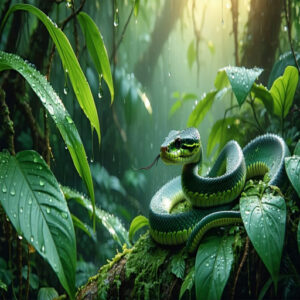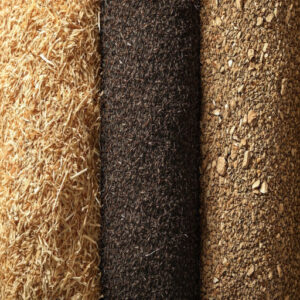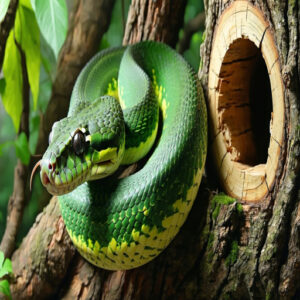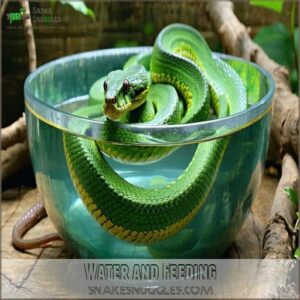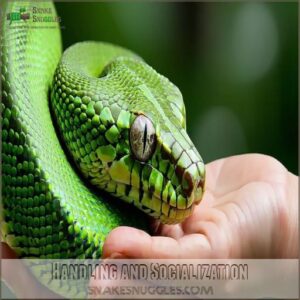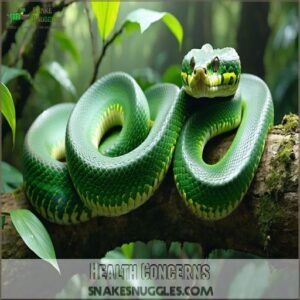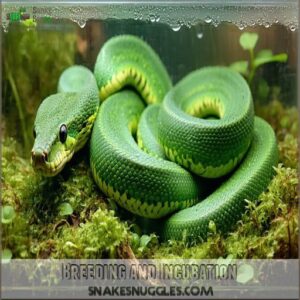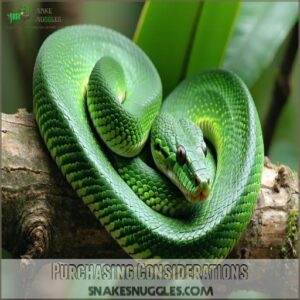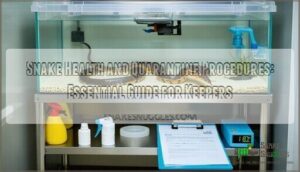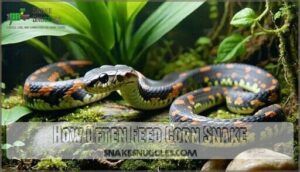This site is supported by our readers. We may earn a commission, at no cost to you, if you purchase through links.
 To care for green tree pythons as pets, create a tall enclosure at least 4 feet high to mimic their arboreal lifestyle.
To care for green tree pythons as pets, create a tall enclosure at least 4 feet high to mimic their arboreal lifestyle.
Maintain a temperature gradient of 78-80°F with a basking spot reaching 88-92°F, while keeping humidity around 60-70%.
Decorate with sturdy branches, live plants, and a damp substrate like coconut fiber.
Feed frozen-thawed rodents weekly, matching prey size to the snake’s body width, and always use tongs to avoid accidental bites.
Handle gently—support their body and avoid sudden movements. These snakes thrive in stable, well-maintained environments, so consistent care’s key.
Want their best colors? Proper lighting and patience go far.
Table Of Contents
- Key Takeaways
- How to Care for Green Tree Pythons as Pets?
- Habitat Requirements
- Enclosure Size
- Heating and Lighting
- Humidity and Ventilation
- Substrate and Decor
- Water and Feeding
- Handling and Socialization
- Health Concerns
- Breeding and Incubation
- Purchasing Considerations
- Frequently Asked Questions (FAQs)
- How to care for green tree pythons as pets?
- Do green tree pythons need a veterinarian?
- Are green tree pythons a good pet?
- How do you keep a green tree python in a terrarium?
- Should you own a green tree python?
- How do you keep a green tree python safe?
- Are green tree pythons easy to take care of?
- Can you keep a green tree python as a pet?
- Do green tree pythons like being held?
- What is the lifespan of a green tree python?
- Conclusion
Key Takeaways
- Set up a tall, escape-proof enclosure with sturdy branches, live plants, and a substrate like coconut fiber to maintain 60–70% humidity.
- Keep the temperature between 78–80°F, with a basking spot around 88–92°F, and monitor it using thermometers for accuracy.
- Feed frozen-thawed rodents every 7–14 days, using tongs to avoid accidental bites, and size meals to match the snake’s body width.
- Handle gently and sparingly, giving your snake time to adjust to its environment, and monitor for health issues like breathing problems or shedding troubles.
How to Care for Green Tree Pythons as Pets?
Caring for a green tree python starts with proper planning and commitment. These arboreal beauty queens thrive with attention to detail.
Begin with a secure and well-designed green tree python enclosure. A solid setup guarantees their safety and mimics their tropical habitat.
Focus on green tree python health by maintaining the right temperature, humidity, and cleanliness—routine enclosure cleaning is vital.
Their diet is simple: rodents, frozen and thawed, fed every 7-14 days based on their size. Handle your snake gently and sparingly at first to build trust, avoiding handling after meals.
Ethical sourcing is key—captive-bred pythons are healthier and adapt better.
Keep an eye out for common diseases like respiratory issues, shedding troubles, or lethargy. A little effort keeps a happy, thriving snake healthy and content.
Habitat Requirements
To create the perfect green tree python habitat, focus on height, enrichment, and security.
Choose enclosure materials like sturdy plastic or wood with ample ventilation to control moisture.
These arboreal snakes thrive in vertically-oriented setups, so make certain the enclosure is at least 4 feet tall with strong perches and branches. For humidity control, aim for 60-70%, using misting, live plants, or a damp substrate like coconut fiber.
A low-wattage bulb mimicking dappled rainforest light showcases their vivid green shades.
Consider a green tree python enclosure specifically designed to meet their habitat needs. Secure access panels tightly—these snakes are escape artists!
A well-planned green tree python enclosure keeps your pet thriving.
Enclosure Size
Choosing the right enclosure size is essential for your green tree python’s health and comfort, so don’t underestimate its importance.
You’ll need a setup that balances enough space for climbing and movement while maintaining an easily regulated environment.
Length and Width
Proper enclosure dimensions mean starting with at least 4 feet long and 2 feet wide for adults. These arboreal beauties thrive with enough room for climbing and stretching. Always prioritize space for their adult size. Juvenile enclosures can be smaller but gradually upgraded.
Remember these four tips:
- Measure Accurately: Verify that terrarium length accommodates adult size needs.
- Prioritize Width: Aim for two feet minimum for comfort.
- Quality Build: The enclosure must stay secure and escape-proof.
- Think Ahead: Juvenile green tree pythons grow fast, so plan upgrades early.
Height
A solid vivarium height of 4-6 feet is perfect for your pet green tree python.
Their climbing height needs sturdy perches and varied branch height.
These athletic snakes love mastering their domain, and taller enclosures promote natural behaviors—like scaling trees—making for a happier, healthier Morelia viridis.
Heating and Lighting
You’ll need to maintain precise temperatures and lighting to keep your green tree python happy and healthy.
Proper heating mimics their tropical habitat.
While lighting supports a natural day-night cycle.
Temperature Gradients
Temperature gradients are essential for your green tree python’s health.
Create an effective setup with:
- Warm side: 78-80°F (digestion aid)
- Cool side: 78-80°F (relaxation zone)
- Night range: 70-75°F (natural rhythm)
Use heat lamps, thermometers, and seasonal adjustments for measuring accuracy.
Basking Area
A well-placed basking spot creates warmth for digestion and comfort.
Position a flat rock or branch under a heat lamp at 88-92°F, angled for belly access.
Elevate it near the heat source in your green tree python enclosure.
Use a probe thermometer for temperature control and maintain a day-night thermal gradient for maximum health and well-being.
Lighting Options
Green tree python lighting should include UVB and heat lamps. Use full-spectrum bulbs with proper wattage on timers for natural light cycles. Carefully position lighting to avoid overheating your snake.
Humidity and Ventilation
Striking the right humidity levels, 40-70%, is vital for keeping your green tree python healthy.
A poorly ventilated enclosure can lead to nasty respiratory issues, so prioritize proper ventilation methods to achieve steady airflow impact.
Use a misting system or fogger to maintain moisture gradients, but don’t just set it and forget it—monitor levels regularly.
Think of their tropical rainforest roots; they thrive with humid air and steady air circulation. To prevent dehydration, make certain the snake has access to a water bowl on the cool side.
With consistent system maintenance and the right balance of humidity and airflow, your python will shed better, breathe easily, and feel right at home.
Substrate and Decor
Choosing the right substrate and decor helps keep your green tree python healthy, comfortable, and stress-free.
Aim for a setup that mimics its natural rainforest habitat.
with secure branches, hides, and humidity-friendly materials.
Substrate Options
Choose a 3-4 inch layer of coconut husk, cypress mulch, or bioactive substrate to maintain moisture levels.
Avoid cedar or pine shavings—they’re harmful.
Substrate hygiene matters, so clean regularly.
For simpler upkeep, consider newspaper for your green tree python’s enclosure.
Hides and Branches
Make your pet green tree python enclosure inviting.
Use sturdy, secure branches for climbing and two hides.
Use naturalistic hide materials and branch placement to mimic trees, adding green tree python enrichment and comfort.
Live Plants
Live plants, like pothos or dwarf umbrella trees, offer natural cover, humidity boosts, and vibrant decor for your green tree python enclosure.
Prioritize reptile-safe plants, proper placement, and consistent plant care for thriving greenery.
For the best snake health, choose plants that thrive in humid conditions and low light, such as plants for snake tank.
Water and Feeding
Providing fresh, clean water in a sturdy bowl is essential to your green tree python’s health and hydration.
Stick to a consistent feeding schedule with properly sized frozen-thawed prey to keep your snake well-nourished and stress-free.
Water Dish
Pick a wide, sturdy water bowl made of non-porous material to prevent bacteria buildup.
Place it on the cooler side of the enclosure.
Change the water daily and clean thoroughly each week for healthier green tree python care.
Prey Types
A proper green tree python diet includes frozen-thawed rodents like mice or rats, selected based on appropriate prey size for your python.
Occasionally, birds can add dietary variety.
Always use feeding tongs for safety, and avoid live prey to prevent injury to your snake during feeding.
Feeding Schedule
Stick to a reliable feeding schedule with these guidelines:
- Hatchlings: Feed every 5-7 days.
- Juveniles: Offer a meal every 7-10 days.
- Adults: Space meals 10-14 days apart.
Prey size matches your python’s widest body.
To avoid health issues like respiratory problems, make certain frozen-thawed prey matches the snake’s body weight.
Handling and Socialization
Handling your green tree python requires patience and steady movements to build trust and avoid stress.
With consistent, calm interactions, you’ll help your snake feel secure while reducing defensive behavior over time.
Initial Acclimation
When bringing your green tree python home, allow a quarantine period to monitor stress signs and health.
Focus on habitat adjustment, proper green tree python humidity, and temperature.
Allow diet adaptation before handling introduction to reduce stress.
It’s vital to follow a proper feeding schedule to guarantee a smooth adaptation and overall health.
Handling Techniques
Approach handling green tree pythons with patience and purpose. Prioritize safe restraint and bite prevention while reducing stress through gentle handling and calm movements.
Be mindful of humid environments to prevent spinal injury risk, especially in areas with low natural humidity levels.
- Support coils fully during handling.
- Use a snake hook if needed.
- Avoid grabbing the head directly—it’s a stress trigger.
- Always monitor body language for signs of discomfort.
Socializing Young Snakes
Start socializing your young green tree python with gentle interaction after early handling. Build trust and use positive reinforcement to make handling enjoyable.
- Be patient—consistency is everything.
- Provide safe spaces during sessions.
- Incorporate enrichment, like climbing perches.
- Move confidently to prevent stress or startling your snake.
Health Concerns
Paying attention to your green tree python’s health is essential for their long, happy life.
Watch for signs like breathing issues, abnormal shedding, or mites.
act quickly if problems arise.
Respiratory Issues
| Watching for respiratory problems: | Symptom | Treatment |
|---|---|---|
| Wheezing | Boost humidity, check ventilation | |
| Breathing struggles | Use warm steam | |
| Pneumonia | Seek reptile vet |
Prevention? Proper humidity supports green tree python health.
Shedding Problems
Shedding problems like stuck shed or retained skin often stem from humidity issues. Maintain proper moisture levels to prevent green tree python skin issues and infections.
Persistent shedding problems can signal underlying illness—consult a vet for preventative care.
Maintaining a temperature gradient of 88-90°F (basking spot) to 78-80°F, as part of a proper green tree python care sheet, is essential to support the snake’s overall health.
- Humidity prevents stuck shed and dry skin.
- Stuck sheds can cause skin infections, worsening health.
- Prompt care avoids long-term green tree python health problems.
Parasites and Mites
Parasites and mites can harm your green tree python if left unmanaged.
Prevention methods include quarantining new arrivals and practicing strict hygiene. For identification, watch for restless behavior or black specks on your snake.
Use reptile-safe sprays and consult a vet for treatment. Consistent mite control keeps your snake healthy and comfortable.
| Mite Control | Parasite Prevention |
|---|---|
| Reptile-safe sprays | Quarantine new snakes |
| Slightly increase humidity | Keep enclosure clean |
| Clean perches and hides | Annual vet fecal exams |
| Vet-prescribed treatment | Disinfect tools regularly |
| Replace infested substrate | Good husbandry practices |
Breeding and Incubation
Breeding green tree pythons can be a rewarding yet challenging process.
It requires careful planning and precise care.
You’ll need to monitor temperature, humidity, and egg development closely to guarantee healthy hatchlings.
Breeding Season
Green tree python breeding begins with careful preparation during the breeding season. By mimicking natural cooling and using strategic pairings, you’ll encourage snake breeding while managing challenges like nest building and post-laying care.
- Breeding triggers: Gradually lower temperatures to initiate activity.
- Male selection: Choose a healthy male with good genetics.
- Mating rituals: Introduce pairs under ideal conditions to encourage successful copulation.
- Nest building encouragement: Provide secure, humid nesting boxes.
- Post-laying care: Support females with hydration and nutrition after laying eggs.
Egg Incubation
Keep green tree python eggs between 86-88°F with humidity levels of 80-90%.
Use an incubator, ensuring steady humidity and avoid over-rotating eggs.
The hatching process typically takes 55-65 days, so be patient and prepare for post-hatch care. This includes incubator setup and maintenance.
Hatchling Care
Caring for hatchlings requires patience and precision. Young green tree python snakes need stable temperature needs, proper humidity control, and gentle handling. Their feeding frequency starts slow as they adjust.
To help them develop properly from the start, invest in a reliable [green tree python incubator](https://zon.every simply.com/green+tree+python+incubator/chewy/).
To help them thrive:
- Maintain a steady temperature of 82-86°F.
- Keep humidity at 60-70% for healthy skin and shedding.
- Offer small, appropriately sized prey weekly.
- Monitor growth regularly to help them develop properly.
Purchasing Considerations
Choosing the right green tree python starts with finding a reputable breeder.
reputable breeder who prioritizes healthy, captive-bred snakes over wild-caught ones.
Ask about feeding habits, health history, and the snake’s background to support a strong start.
Reputable Breeders
Choose reputable breeders who prioritize genetic diversity, ethical sourcing, and clear health guarantees.
Experienced breeders guarantee your green tree python purchase meets high standards, offering a healthy, well-socialized Morelia viridis with pricing transparency and trustworthy care support.
Many breeders also offer products and supplies for green tree python care through online marketplaces like reptile pet products.
Captive-bred Vs Wild-caught
Captive-bred green tree pythons are the smart pick for beginners. Why? They’re healthier, calmer, and ethically sourced. While wild green tree pythons might cost less, the risks stack up. Here’s why captive-bred wins every time:
- Ethical sourcing guarantees you’re supporting conservation, not harmful practices.
- Genetic diversity means stronger, healthier pet snakes free from inbreeding issues.
- Fewer health risks, including parasites or infections, often plague wild green tree pythons.
- Temperament variations make captive-bred snakes easier to handle and socialize.
- No surprises with captive-bred snakes—they adjust to captivity, unlike their wild-caught counterparts.
Evaluating Health
Inspect the snake’s weight, signs of consistent appetite, smooth shedding, breathing clarity, and nighttime activity levels.
Use this checklist to spot green tree python health problems early.
Reputable breeders prioritize snake care, avoiding typical green tree python feeding problems.
| Trait | Healthy Python | Potential Problem |
|---|---|---|
| Weight | Well-proportioned | Underweight or bloated |
| Appetite | Eats regularly | Refuses food |
| Shedding | Full, clean sheds | Retained patches or flakes |
| Breathing | Silent, steady | Wheezing or clicking |
Frequently Asked Questions (FAQs)
How to care for green tree pythons as pets?
Caring for green tree pythons is like balancing art and science.
Maintain 78-88°F temps, 50-70% humidity, sturdy branches, and hides.
Feed thawed rodents every 7-14 days.
To create a suitable environment, research recommended Green Tree Python Care.
Handle gently; monitor for stress and health issues.
Do green tree pythons need a veterinarian?
Yes, green tree pythons need a reptile vet for regular checkups.
and when signs of illness appear, like wheezing or lethargy.
Don’t skip preventive care—it might save issues later and your snake’s life!
Are green tree pythons a good pet?
Imagine owning a stunning emerald jewel that moves—green tree pythons are beautiful yet demanding.
They’re better for experienced keepers.
Due to their precise care needs, shy nature, and potential for biting when startled.
How do you keep a green tree python in a terrarium?
Set up a secure, front-access terrarium with sturdy branches, hanging plants, and proper hides.
Maintain a temperature gradient of 78-88°F, 40-70% humidity, and see to regular misting.
Use bioactive substrates for enrichment. This will help with terrarium setup.
Should you own a green tree python?
Owning a green tree python isn’t for everyone.
They’re beautiful but require precise care, advanced knowledge, and patience.
If you’re ready for a long-term commitment and love reptiles, they make fascinating pets.
How do you keep a green tree python safe?
Protect your green tree python like a treasure by securing its enclosure, maintaining its temperature and humidity perfectly, and using sturdy perches.
Never handle it after feeding.
Watch for clear signs of illness.
Are green tree pythons easy to take care of?
Green tree pythons aren’t the easiest pets.
They’re sensitive to temperature, humidity, and stress, needing precise care.
With patience and knowledge, though, they thrive, offering rewarding companionship for experienced keepers who love a challenge.
Can you keep a green tree python as a pet?
You can absolutely keep a green tree python as a pet, but they’re best suited for experienced keepers.
These snakes need specific temperatures, high humidity, and careful handling to thrive.
making dedication and research essential.
Do green tree pythons like being held?
These pythons aren’t cuddle enthusiasts.
They tolerate handling if socialized as babies, but prefer hanging out on their perch.
Handle gently, with respect for their space—think of it as earning their trust, not hugs.
What is the lifespan of a green tree python?
Green tree pythons can live 15 to 20+ years with proper care.
Their lifespan depends heavily on consistent humidity, correct temperatures, and a healthy diet.
It’s a long-term commitment, but their beauty makes it worthwhile.
Conclusion
Fun fact: green tree pythons can live over 20 years with proper care, making them a long-term commitment.
To keep yours healthy and glowing with vibrant colors, focus on creating the right habitat—tall enclosures, controlled temperatures, and 60-70% humidity are musts.
Feed appropriately and handle with care to build trust.
Learning how to care for green tree pythons as pets takes patience, but with consistent attention, you’ll have a striking, low-maintenance companion that’s truly rewarding.



